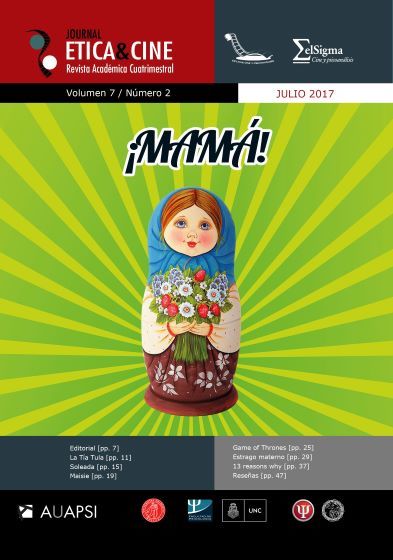13 Reasons why: Ethical challenges about suicide in a TV Series
DOI:
https://doi.org/10.31056/2250.5415.v7.n2.18975Keywords:
Films, Suicide, Bullying, PsychoanalysisAbstract
Can we really talk about “reasons” for a teen to commit suicide? Alejandro Ariel once said that “suicide is something that should not happen”, not in the sense of a moral condemnation but to question its character of inevitability. The approach of teen suicide through a television series provides a new twist, given that series are the contemporary relay of cinema for the general public. Daily, television series reach millions of viewers in the world, as novels or radio used to do before. The stories presented manage to convey the situational pathos and allow an unprecedented treatment of the problems. They can be used in a psychotherapeutic framework (as cinematherapy, for example) or as starting points for ethical-clinical analysis of on-screen fictions. The series 13 Reasons Why (Netflix, 2017) has been a success precisely because it shows us the «bullying» phenomenon in a radically different way, introducing the horizon of death, thus raising questions for bioethics and psychoanalysis. In this paper we investigate some crucial categories, such as institutional and subjective responsibility, sexual violence, acting out and passage to act. The lessons of the series are therefore extracted as a privileged cultural form that allows us to transmit, interrogate and analyze in a unique and moving way the singularities in situation.Downloads
References
Assef, J. (2013). La Subjetividad Hipermoderna. Una lectura de la época desde el cine, la semiótica y el psicoanálisis. Buenos Aires: Grama Ediciones.
Duek, D. (2016). Intersecciones: Los otros, los jóvenes y los discursos sociales. Actualidad Psicológica. Enero 2016.
Grassi, A. (2010) Adolescencia: reorganización y nuevos modelos de subjetividad. En:Entre niños, adolescentes y funciones parentales. Psicoanálisis e interdisciplina (pp. 29-44). Buenos Aires: Editorial Entreideas.
Gómez, M.; Michel Fariña, J.J. (2012). Series: una interpretación del síntoma. Ética y Cine Journal, 2(2), 9-10.
Lacan, J. (1963). El Seminario 10. La Angustia, Clase IX, Buenos Aires: Paidós, 2006.
Maroño, M. R. (2016). Cualidades fácticas y psíquicas del proceso puberal en niñas. Tesis de Doctorado en Psicología. Universidad del Salvador. Inédita.
Michel Fariña, J., Salomone, G. et al (2007): Logos, Pathos, Ethos: Developing Ethical Sensitivity in Argentinean Teachers using the Racial and Ethical Sensitivity Test (REST). Annual Meeting of the Association for Moral Education, New York University, November 2007.
Nasio, J.D. (2011). Cómo actuar con un adolescente difícil. Buenos Aires: Paidós.
Olweus, D. (1998). Conductas de acoso y amenaza entre escolares. Madrid: Ediciones Morat.
Smith, P.K, Mahdavi, J., Carvalho, C., Fisher, S., Russell, S., y Tippett, N. (2008). Cyberbullying: Its nature and impact in secondary school pupils. Journal of Child Psychology and Psychiatry, 49, 376-385.
Travnik, C. (2014) El acoso escolar: una encerrona trágica. Ética y Cine Journal, 4(2), 53-57
World Health Organization. Prevención del suicidio: Un instrumento para los medios de comunicación [Internet]. Geneva: World Health Organization; 2000. Disponible en: http://www.who.int/mental_health/media/media_spanish.pdf
World Health Organization (2012). Prevención del suicidio: un imperativo global. Disponible en: http://www.who.int/mental_health/suicide-prevention/es/
World Health Organization (2014). Preventing suicide: A global imperative. Disponible en: http://apps.who.int/iris/bitstream/10665/131056/1/9789241564 79_eng.pdf
Downloads
Published
How to Cite
Issue
Section
License
Los autores que publiquen en Ética y Cine Journal aceptan las siguientes condiciones:
Los autores/as conservan los derechos de autor © y permiten la publicación a Ética y Cine Journal, bajo licencia CC BY-SA / Reconocimiento - Reconocimiento-CompartirIgual 4.0 Internacional. La adopción de esta licencia permite copiar, redistribuir, comunicar públicamente la obra, reconociendo los créditos de la misma, y construir sobre el material publicado, debiendo otorgar el crédito apropiado a través de un enlace a la licencia e indicando si se realizaron cambios.

Este obra está bajo una licencia de Creative Commons Reconocimiento-CompartirIgual 4.0 Internacional.




